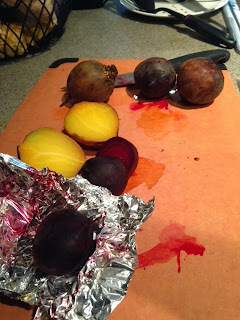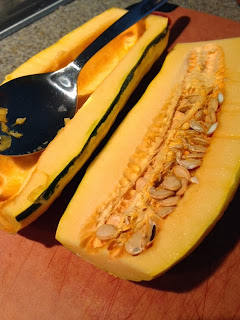It was time to clean out the fridge today and that is
exactly how this cocnut curry came to be. Curries are great because they pack a
lot of flavor and creaminess without all the fat and calories. This is not
always the case for curries you will find at restaurants, but you can make this
one at home knowing it is full of healthy goodness.
Roasting the beets is simple but may be a bit time consuming.
You can make them up front and store them in the fridge until you are ready to
make the curry and then the recipe is a cinch. Go ahead and make extra to use
on salads later in the week.
Coconut Curry with
Beets, Beans & Kale
Ingredients
- 3 cups roasted beets, cubed
- 1 15-oz can garbanzo beans, drained and rinsed
- 2 cups lactino kale, chopped
- 2 cups coconut milk
- 1 Tbsp curry spice blend
- 1 tsp cinnamon
Preparation Instructions
How to roast beets:
- Pre-heat oven to 400 degrees F.
- Wash beets and wrap each individually in tinfoil.
- Place in a baking dish and roast for 60-90 minutes. This will vary depending on the size of your beets. I roasted mine for 90 minutes.
- Remove beets from tinfoil and rub off skin. Skins should rub off fairly easily after roasting.
- Cut into cubes.
Making the curry:
- Simmer the coconut milk with curry and cinnamon for about 5 minutes.
- Add beets, beans and kale, then continue to simmer for 10 more minutes.
- Dish into 2 servings (~3 cups each). Serve warm.
Fuel Facts
Numbers: 312 calories, 13 g protein, 9 g fat, 47 g carbs, 11
g fiber
Ingredient Breakdown:
v
Beets –
Not only do beets have a beautiful color and flavor, they boast a large array
of health benefits. Many of these can be
attributed to betaine, a nutrient that acts as a methyl donor. So what does
that mean exactly? By lending methyl groups, betaine assists in many important
metabolic pathways. This is of particular benefit to the liver, helping to break
down hepatic (liver) fat stores and to optimize liver function.
Another thing you may not know about beets
is their ability to enhance sex drive. In ancient Rome, beets were considered
an aphrodisiac. Today we know this is due to their high boron content. Boron
has been linked to increased production of estrogen in post-menopausal women
and testosterone in men.
v
Beans –
The legumes are a wonderful protein source for those wanting to increase their
intake of plant-based foods. Beans have a very high content of fiber as well
which is associated with lower blood cholesterol levels, decreased risk of
heart disease and lower body fat. It is recommended to get at least 25 grams of
fiber a day.
v
Kale –
You won’t here me use the word “super” food very often, because I believe all
foods contribute their own, unique healing powers. That being said, if there
was one food to eat more of, it would be kale. Studies continue to show kale’s
ability to lower the risk for cancer, prevent inflammation and even act as a
detoxifier at the genetic level. Bottom line… eat more kale.
v
Coconut
milk – A great dairy and lactose free milke alternative, coconut milk is
naturally creamy and therefore a great addition to smoothies, soups, coffee,
and as a milk substitute for baking. The fats in coconut milk are medium chain
fats which are not readily stored by the body and will subsequently be burned
for energy.
v
Curry
– The combination of spices used in curry each boast their own health benefits.
The five that typically make up curry are turmeric, cumin, coriander, mustard
seed and chili powder.
v
Cinnamon – Many studies have shown the
stabilizing effects of cinnamon on blood sugar. This is beneficial for anyone
who wants to keep energy levels constant throughout the day, and especially
helpful for diabetics or those who experience hypoglycemia. Cinnamon has also
been shown to act as an anti-inflammatory by limiting the release of
arachidonic acid from cell membranes, a fatty acid that typically causes inflammation.



















